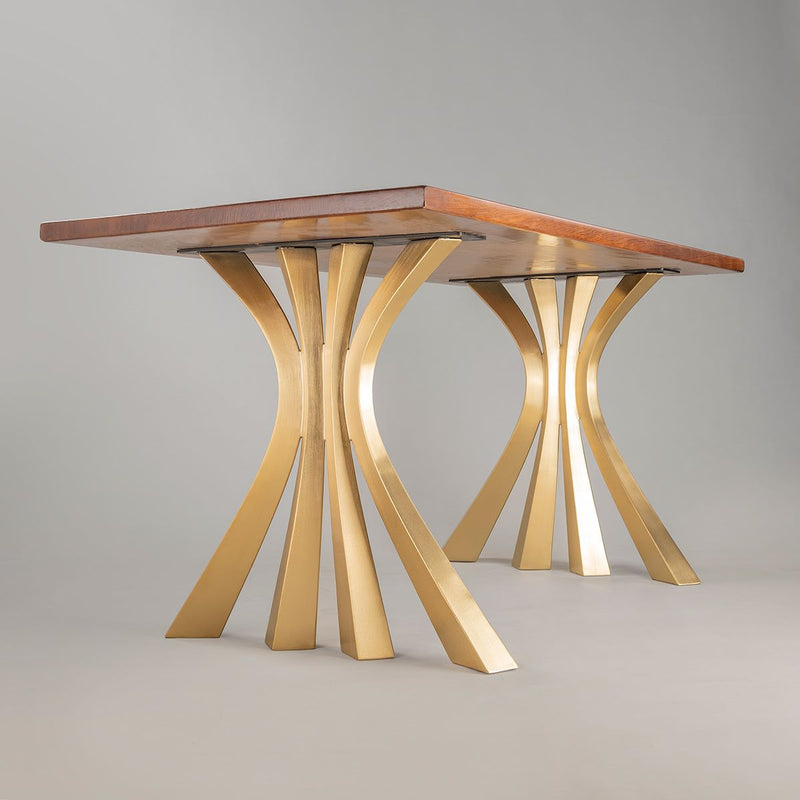An In-depth Check Out Table Leg Styles: Finding the Perfect Suit
Choosing the appropriate dining table leg design is essential for both visual appeal and useful performance. For those with larger tables, trestle legs ensure durable support, whereas barrette legs present a mid-century contemporary ambiance with their minimal layout. The x-shaped legs blend contemporary style with improved security.
Traditional 4 Legs
Amongst the numerous kinds of dining table leg designs, the conventional four-leg style continues to be a timeless choice for several households. Four legs supply balanced assistance, guaranteeing the table remains steady and qualified of bearing significant weight (dining room table legs).
From a visual point of view, the traditional four-leg style can be quickly adapted to different interior styles. Whether crafted from timber, steel, or a mix of materials, these legs can be elaborately carved, smooth and minimalistic, or anything in between. Their convenience allows them to enhance both rustic and modern settings effortlessly.
Moreover, the uncomplicated structure of the four-leg design promotes convenience of activity and positioning within an area. Unlike even more complicated bases, this design lessens blockages, giving enough legroom for restaurants. In summary, the typical four-leg dining table leg style marries sustaining sophistication with sensible performance, making it a sharp option for those seeking both form and feature in their dining furniture.
Pedestal Base
Commonly commemorated for its classy and space-efficient style, the stand base is a notable choice to the standard four-leg arrangement in dining table leg designs. This unique base commonly includes a single central column supporting the table top, which can differ in type, from ornately sculpted timber to smooth, contemporary steel. One of the primary benefits of the stand base is its capability to make best use of legroom and seating versatility. Without corner legs, diners are paid for higher flexibility of activity, making it an ideal option for round and oblong tables that advertise more intimate and inclusive events.
The main column itself supplies a canvas for detailed styles and artistic expressions, adding a component of visual rate of interest under the table. In recap, the stand base integrates functionality with style, making it a refined and practical alternative for diverse dining environments.
Trestle Legs
Trestle legs offer a robust and timeless structure for eating tables, identified by their straight cross-bracing and tough support light beams. Stemming from medieval times, this style has advanced yet retained its essential structure, making it a seasonal fave in both traditional and modern settings. The central trestle beam of light, usually sustained by two or even more vertical articles, offers exceptional stability, permitting larger table lengths without the need for additional legs.
A substantial advantage of trestle leg tables is the ample legroom they provide. Unlike tables with 4 corner legs, the absence of obstructions at the table's sides supplies unimpeded space for chairs and restaurants, improving comfort and availability. This makes trestle tables suitable for suiting bigger gatherings, whether in a dining-room or a reception hall.
The visual convenience of trestle legs is significant. Available in a range of products such as timber, metal, and composite, they can be ended up to enhance a wide variety of interior styles. From rustic farmhouse to sleek modern-day styles, trestle legs can be tailored to fit specific tastes. Their long-lasting appeal and functional benefits make trestle legs a compelling selection for those seeking both design and usefulness in their table.
Barrette Legs

The appeal of hairpin legs hinges on their simpleness and versatility - dining room table legs. Readily available in a series of materials, my company including steel and brass, they can be finished in numerous shades to match various indoor designs. Whether paired with a rustic wooden table top or a modern glass surface, barrette legs effortlessly blend functionality with a touch of vintage charm
Longevity is an additional remarkable feature of hairpin legs. In spite of their fragile appearance, these legs are engineered to birth considerable weight, guaranteeing the dining table stays steady and safe and secure. Furthermore, they are reasonably very easy to mount, making them a prominent option for DIY lovers and specialist furnishings manufacturers alike.
X-Shaped Legs

Created from materials such as steel, wood, or a combination of both, X-shaped company website legs can be tailored to match numerous layout preferences. Steel legs usually offer a streamlined and industrial feel, ideal for loft-style apartments and modern-day eating spaces. On the various other hand, wood X-shaped legs offer a warmer, much more rustic appeal, suitable for farmhouse or eclectic insides. The flexibility in materials enables property owners to customize their eating tables to better fit their total design plan.
Furthermore, the design behind X-shaped legs makes certain even weight circulation, minimizing the threat of wobbling and improving sturdiness. This makes them especially appropriate for larger dining tables that call for extra support. Essentially, X-shaped legs mix sensible design with modern visual appeals, making them a timeless selection for varied dining atmospheres.
Conclusion
A comprehensive understanding of table leg designs exposes the distinctive qualities and benefits of each style. Typical 4 legs use stability and timeless allure, while pedestal bases supply legroom and a structured appearance. Trestle legs guarantee durable assistance for bigger tables, and hairpin legs introduce a mid-century contemporary visual. X-shaped legs combine modern design with boosted stability. Picking the ideal leg style guarantees both functional and visual contentment in any kind of eating room.